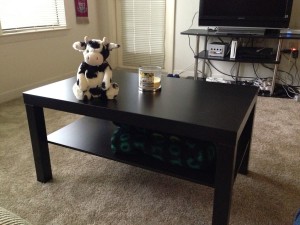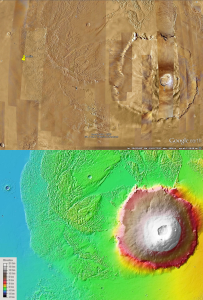Hello again from good ol’ Daytona Beach!

My brand new coffee table from IKEA – it really makes the living room feel like a living room. And I put it together all by myself! 😀
My life is virtually the same as it was last time I wrote. It’s still way too hot and rains a lot – but that’s all I will say about that, because I promised no more complaining about the weather. I did get the leak in my car fixed, so at least now when I drive in the rain my feet stay dry! The Summer A semester is already winding down – my final exam is this weekend! It’s crazy how fast it went. I’ll definitely have to give two thumbs up to summer classes. I’m really looking forward to having my first three grad credits under my belt. Last weekend I went down to IKEA in Orlando with some friends to get new furniture for my apartment. IKEA is always fun; if you haven’t been you should definitely go. It’s like one the essentials of being in college. Not to mention spending two hours assembling a dresser at midnight really brings people closer together. Aside from all of that I’ve been doing a lot of the same old stuff. School, work TV, music, eating a lot of Indian food take-out (I’m a little bit addicted.)

A map of the location on Mars where we are simulating gravity waves, and the corresponding altitude map. The big mountain on the right is Olympus Mons.
My research in SPRL has been going really well. We’ve been working on simulating gravity waves near Olympus Mons, which is the largest mountain in the solar system, measuring up to about 22 km high (that’s 14 miles for those of you stuck on the English system.) There are a few different types of gravity waves but the type we are working with are Buoyancy Waves, which are caused by, you guessed it, the buoyancy force. Basically what happens is that air particles are forced to move upwards in the atmosphere because there’s a giant mountain in their way. Because the air at the base of the mountain is more dense than the air it’s now surrounded by, gravity pulls it back down. Think of it like taking a pingpong ball and pushing it down into a bath tub – once you let go it flies back up into the air because it overcompensates for the density difference. Air does this too, and as gravity pulls the air down, it pulls it too far, and the buoyancy force tries to fix this by pushing it back up – but too far again and the cycle repeats over and over again creating a wave in the air.

A time-lapse plot of a wave we simulated on Mars, which has a wavelength of about 40 km! You can see that as time passes the wave moves up and begins to reflect on itself – we are further investigating this phenomenon.
These waves are similar to ripples in a pond, but way bigger – with wavelengths of tens of kilometers long. That’s huge! In general they can’t be seen by the naked eye, however they often cause ripples that allow us to observe the waves. The waves on Mars are pretty cool. They are larger than the waves on Earth, due to the fact that the Martian atmosphere has a much lower Brunt-Väisälä frequency (I’ll explain about that later.) They also do not make it as far into the upper-atmosphere as they do on Earth, and tend to reflect upon each other around 60 km. We are now working on simulating a wave over Olympus Mons with a realistic wind profile, whereas until now we have assumed zero wind. The results have been very cool so far, and I’ll definitely have something to report next week.

Plots comparing the buoyancy frequency and period for Earth (blue) and Mars (red) with respect to altitude.
So I should probably explain the Brunt-Väisälä frequency. (Super cool name, right?) This is the natural frequency at which the atmosphere resonates. Think of it like when you tap on a wine glass – the sound it makes is its resonant frequency, the sound the glass wants to make based on its size, material, etc. This happens in the atmosphere as well, however the waves are much larger (like I mentioned in the last entry) so we can’t actually hear the sound. In the atmosphere, the resonant frequency is based on the temperature, density, chemical make-up, etc., and is the maximum possible frequency for gravity waves. On Mars, the Brunt-Väisälä frequency is much lower, resulting in much larger waves. For example, on Earth, gravity waves have typical periods of 5-8 minutes, whereas on Mars they are more like 15 minutes. In comparison, sound waves have periods on the order of milliseconds – so you can see how much larger the gravity waves really are!
I feel like I should have more to say, but my life is pretty boring. Well, I leave for the CEDAR conference on Saturday after my final exam… it’s definitely crunch time! I’m really looking forward to the trip, and hoping the weather in Colorado will be nice. I’ve never been to Colorado, but I know that that part of the country is beautiful. I’m also looking forward to having a Caribou Coffee in the Denver airport! (Starbucks has nothin’ on Caribou – midwesterners will know what I’m talking about.)
Tune in after the conference, I’m sure I’ll have a lot to write about! That’s all folks.
-Lynsey
schroel2@my.erau.edu


